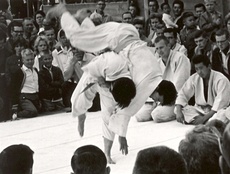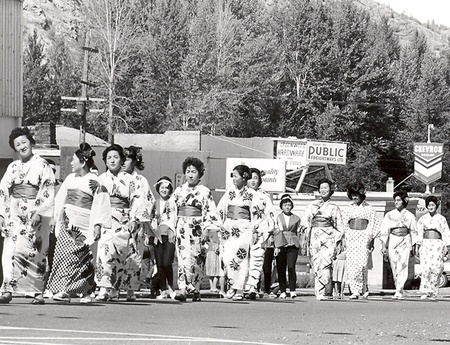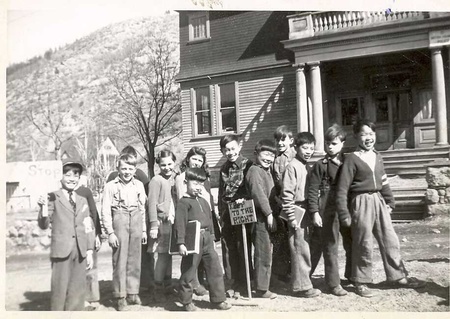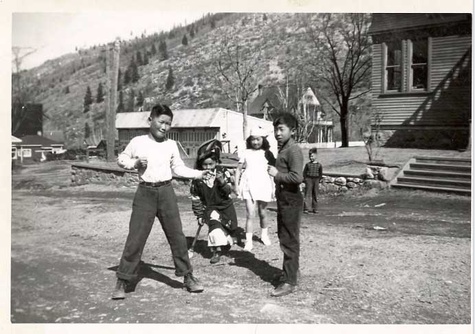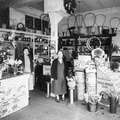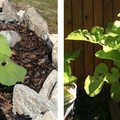AUTUMN: Labour Day celebration marked the end of summer in Greenwood and the beginning of a new school year. This was the day for everyone to dress up and take in the parade with marching band, various sponsored floats and decorated bicycles. Police car and fire truck was a must. Children loved hearing the siren. Sacred Heart School floats did well each year and a great pride and joy of the Franciscan Sisters and Friars. Most Nikkei children went to SHS. Everyone in the community looked forward to karinto and chow mein sale. The climax of the evening was the giant firework show. Next morning, the boys collected these empty shells to make into toy cannons.
In 1964, Greenwood held a Natsu Matsuri or Summer Festival. This was one year the Nikkei community showcased their culture. The parade had rickshaw, Tanko Bushi dancers dressed in kimonos, judo demonstration, and the main platform was in the style of a Japanese gazebo. Beautiful B.C. magazine did a feature on this celebration in the 1965 Summer issue.
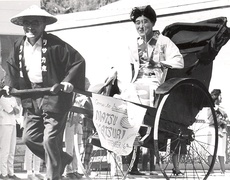
As October rolled around, it was hanabi or firecracker month! Pack of firecrackers could be bought for a nickel or dime. The powerful Atom hanabi was fifteen cents. There were hundreds of children throwing firecrackers in the alley, side and main street. Most adults must have tolerated all that noise because children didn’t hear any complaints.
Children became creative with the use of firecrackers. One was to plug the bottom end of a small firecracker and to test his ‘manhood’, a child lit the firecracker and held it high in the air. If it was air-tight, the firecracker exploded upwards and the child didn’t burn his fingers. Another was to place the Atom firecracker inside a cigar container. Add the wings and voila, it became a missile! Children placed the firecrackers in the fine dust to see how it would explode. Most of the children had a contest to see who could hold onto the firecracker the longest, then, released it at the last moment. This way everyone could see the firecrackers exploding in the air. I remember watching one kid’s firecracker exploding just a few feet away from his hand!
I don’t remember Thanksgiving that much, but the only thing I remember was my dad one day brought home about four turkeys at the Turkey Shoot. I was puzzled. He never owned a gun and he was afraid to shoot a rifle. I asked him how he won so many turkeys? Shyly and slyly, he mimicked a gesture of a man rolling dice!
Hunting was another popular activity. Most children owned a BB gun or a single shot .22 rifle. Most homes had a rifle under the bed. Yet, no one died or was murdered with a rifle in domestic affairs. There was one hunting accident to my knowledge. Grouse hunting was for the younger children. Adults went deer hunting.
Yes, there were some close calls. Some of the boys went up to the smelter to hunt or for target practicing. My friend had his .22 rifle leaning on his hip with the barrel pointing upwards. I asked if the rifle was loaded. He replied no. Then, the rifle slipped off his hip and when the rifle hit the ground, bang!
Another time, the boys allowed this elderly man to join in on the grouse hunt since he had a 12-gauge shotgun. The boys only had .22 rifles. When the prized Blue Grouse flew in the air, they all took shots and made a kill. The boys ran to retrieve the grouse. Meanwhile, the elderly man was so excited, he ran to keep up with the younger guys. Bang! The pellets from his shotgun flew over our heads and splattered a huge boulder above us!
My younger brother bought a new rifle so he wanted to set the sight accurately. We went to the rancher’s hayfield to set up a target. As my brother walked a distance away, he spotted a bear sauntering down from the woods. He yelled, “Bear!” The bear was more in shock than my brother so it took off back into the mountains!
One other time, few of the boys went up to Deadwood Flat for target shooting. My friend had his father’s WWII Enfield rifle. We sat around this small slough that formed near the irrigation pump. Out of the blue, he blasted a shot into the pool of water! Our ears were ringing crazily! I asked why he did that, and his reply was, “I saw a frog.” Another close call.
End of October was Halloween. Most of the children just wore home-made masks. A paper plate was great to draw and paint monsters. Brown paper bag also sufficed. Some were able to buy store-bought masks because they were affordable. The most important accessory was the bag. If children used Kokuho cloth rice sacks, they were Nikkei. Some used gunny-sacks because they held more candies. Back in those days, children went from one end of the town to the other. That meant more goodies. Children had to go home because the sack was full, then they went back trick or treating to fill up again. The smart kids knew where to go first. The Hamanishi family gave money and there were few Nikkei mothers who made delicious karinto. Apparently, my dad gave out firecrackers so our family was in the “Go First” category.
Some families had ten children so imagine how much goodies were on the kitchen table. They could have opened up a candy store!
The evening got dark quickly but children went in groups so it was safe. Most dreaded was the apple because it was so heavy. Some even gave out potatoes! One family didn’t give the children treats unless they sang.
We did all this without parent supervision. The older brothers and sisters took care of the little ones.
© 2017 Chuck Tasaka



